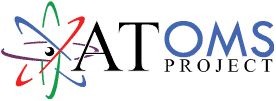ATOMS Project Technical Report:
Models and Taxonomies Relating to Assistive Technology
Roger O. Smith, PhD, OT, Jamie Seitz, BS, OTS, Carleen Jansen, BS, OTS and Kathy Longenecker Rust, MS, OT
Table of Contents
Introduction and Purpose of the Technical Report
A comprehensive literature review on assistive technology (AT) taxonomies and models served as the basis for this ATOMS Project fieldscan and this technical report. The investigation was undertaken to better understand the conceptual underpinnings of AT outcomes variables for developing the next generation of measurement systems. The fieldscan resulted in a comprehensive categorization of models and taxonomies relevant to AT outcomes measurement: the ATOMS Project Models and Taxonomies Resource. The resource provides a background for the scope and definition of assistive technology as well as its theoretical taxonomic supports. The ATOMS Project team hopes that this public web resource is helpful for students, professionals, and researchers by making these models and taxonomies more accessible.
Background
Several authors have published previous reviews of AT outcomes models and taxonomies (Edyburn, 2001; Fuhrer, Jutai, Scherer, & DeRuyter, 2003; Lenker & Paquet, 2004). While each of the reviews draws important conclusions, often leading to a new model, the reviews tend to focus their attention on specific taxonomies in their literature reviews. For example, in 2001 Edyburn highlighted 12 models that impact the knowledge base of special education technology. The author reviewed significant and reputable models and established a comprehensive collection. However, since the review was constrained to the field of special education, this representation is only a subset of the larger array of AT outcomes models and taxonomies. As represented by the ellipses of ATOMS logo, four service areas surround the individual who uses AT: educational, medical, vocational, and independent living models. (See Figure 1) Education is only one of the areas. All of the service areas need to be considered for a comprehensive aggregation of AT outcomes models and taxonomies.
Figure 1
Click for Full Text Description

In 2003 Fuhrer, Jutai, Scherer, and DeRuyter developed a framework for modeling the outcomes of AT devices. In devising this model they included reviews of previously developed models and theories. However, the purpose of the paper was to describe their framework. Thus, their model and taxonomy review was neither detailed nor inclusive of the field. A year later, in 2004, Lenker and Paquet proposed a model for predicting AT usage. In doing so, they reviewed six conceptual models: the Human Activity-Assistive Technology (HAAT) model; the International Classification of Functioning, Disability, and Health (ICF) model; the Matching Person and Technology (MPT) model; Gitlin’s biopsychosocial model of an AT user's 'career'; social cognition decision-making theories; and, the Perceived Attributes theory for predicting consumer adoption of product innovations. These reviews provided careful discussion that resulted in the author's proposed new model.
Given the documented need and past attempts to aggregate and synthesize AT outcomes variable models that describe theoretical intentions but acknowledge their limitations in scope, this fieldscan attempted to compile a more comprehensive resource. Efforts resulted in a comprehensive catalog (52 listings) of models and taxonomies relevant to AT outcomes research and practice.
Development of the Resource
To develop the ATOMS Project Models and Taxonomies Resource, we performed an extensive review of the AT and rehabilitation literature. A total of 52 models and taxonomies were ultimately selected for the resource. Thirty-eight models and 14 taxonomies comprise the presentations. Within the 38 models presented in the resource, 22 are AT specific, 7 are somewhat specific to AT, and 9 are not AT specific. Within the 14 taxonomies, six are AT specific, 2 are somewhat AT specific, and 6 are not AT specific. The Models and Taxonomies Resource does not encompass tools used to measure outcomes (AT evaluation instruments remain outside the scope of this report, but are provided as a mini-database elsewhere in the ATOMS Project website.) This report presents models and taxonomies used to describe AT and the impact it can have on an individual. The models and taxonomies range in date from 1965 to 2004 and are drawn from the fields of health science, occupational therapy, rehabilitation, education, medical science, engineering, and social science. Examples of the spectrum of journal titles from which they emerged include Occupational Therapy in Health Care, Journal of Industrial Ergonomics, Assistive Technology, as well as Disability and Rehabilitation.
The content of this report provides detailed information regarding each taxonomy and model including:
- Whether it is a taxonomy or model
- Title
- Year of publication
- Reference
- Website (if applicable)
- Brief description
- Whether or not it is AT specific
- Whethera figure is provided in the original source and where in the source it is located
- Number of components and levels
- Examples of components and levels
- An accessible summary text description of the figure (if applicable)
- An accessible detailed text description of the figure (if applicable)
This resource is arranged as a table of basic data with links to more complete descriptions.
Models and Taxonomies Resource (248KB)
Acknowledgement
The ATOMS Project and this work are supported in part by the National Institute on Disability and Rehabilitation Research (NIDRR), grant number H133A010403. The opinions contained in this publication are those of the grantee and do not necessarily reflect those of the NIDRR and the U.S. department of Education.
References
Edyburn, D. L. (2001). "Models, theories, and frameworks: Contributions to understanding special education technology." Special Education Technology Practice: 16-24.
Fuhrer, M. J., Jutai, J. W., Scherer, M. J., & DeRuyter, F. (2003). A framework for the conceptual modeling of assistive technology device outcomes. Disability and Rehabilitation, 25(22), 1243-1251.
Lenker, J. A., & Paquet, V. L. (2004). A new conceptual model for assistive technology outcomes research and practice. Assistive Technology, 16(1), 1-10.




